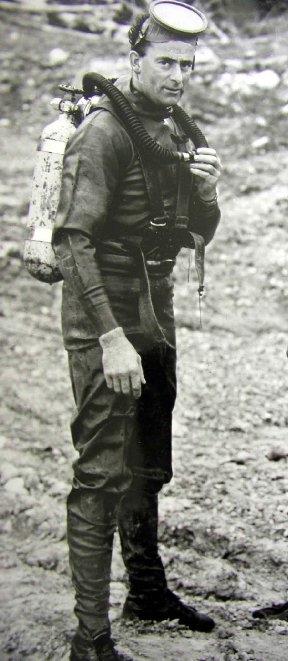Les Subritzky – A New Zealand Diving Legend
By Keith Gordon
In our younger diving days we often read in NZ newspapers, stories of the feats of commercial diver Les Subritzky. Later in the 1960’s, I met up with Les carrying out an inspection of the Apia, Samoa, wharf concrete pilings. While testing a Desco full facemask hooka rig on the newly constructed wharf, I had come across a number of piles where, underwater and out of sight, a number of pilings were minus their concrete casing, only the steel beam and wire cages existed. Les was by then a well- known commercial diver and was brought in from NZ to inspect the contractor’s work. Over the years since, I have read many antidotes on the underwater adventures of Les.
Recently I visited his son Ken who kindly allowed me to look through old family scrapbooks of news and magazine articles reporting Les’s diving history – much more than can be related in an article such as this. Les came from a seafaring family and as a small boy growing up in Northland, New Zealand; he read every book on the undersea world he could get his hands on. In 1937 at the age of 14, he built his first surface supplied underwater breathing rig using gas mask components and dived the system in the local river – he was bitten for life. During the War, Les was involved with constructing a harbour boom defence and the Navy supplied him with a basic oxygen diving apparatus to aid the work, he immediately stripped it down and modified the rig to work better than original. Following the War, Les worked for a period with TEAL at their Mechanics Bay, Auckland, flying boat base.
Working off ocean pontoons the mechanics often dropped tools and equipment into the drink. Les constructed a diving apparatus using an old fire extinguisher cylinder, a gasmask face-mask and breathing tube and a length of hose with a float used as a ‘snort’ tube for breathing out – this he stated, prevented bubbles near his head which caused vibrations in his ears. Using this rig and wearing shoes to protect his feet, Les would, with the aid of a 56-pound weight lowered by rope and hauled up later, submerge down to around eight-metres and recover the lost equipment. He could remain underwater by reaching behind when he required a breath, turn the valve on and off for air supply, then hold his breath, let it out and then repeat the performance. The local press picked up on his diving activities and a feature appeared in the local papers on the “amateur frogman” who walked on the harbour bed and remained underwater for 30-minutes. Encouraged by the possibilities that lay underwater, Les thought there must be an easier way and made a demand-valve from information he found in an American magazine.
After a lot of experimenting and modification he used this “terrible-looking” demand-valve for many years. Les later patented a demand regulator of his own design but earlier, using acquired wartime oxygen rebreather systems and equipment of his own manufacture including a homemade “dry-suit”, he had started to make a name diving around the Auckland waterfront carrying out various underwater tasks. This included police work; on one such callout he was required to search the harbour bed below a docked ship for a knife used in the slaying of a crew member. Ken recalls Les received threats on his family if he searched for the knife but re-assured by the police of their protection, he went ahead and found the killers knife on the seabed below the ship.
Les designed and made several underwater camera housings and took some of the first underwater movie film recorded in NZ. His movie camera housings were pieces of art and one was fitted with an “aqualung” system to equalize the housing pressure. He made the majority of his equipment on the basis that he knew he could rely on it and was not depending on others for his safety. He recorded many underwater scenes on film including in 1955, his exploration of the wreck of the Wiltshire in a depth of 100 feet. With the advent of television and using a studio TV camera (long before hand held video cameras), Les made an underwater TV system designed for use to 180 feet. He first used the system to survey an oil leak in the stern tube of the MV Rangitane.
Shipwrecks that dotted the coastline had at that time, had little salvage work carried out on them and attracted Les’s attention. These included the Wiltshire, the Waiarapa and the Elingamite, all wrecks which had been only dived previously by helmet divers. One story told to me, was of when Les decided to have a go at salvaging the condenser off the Wiltshire, sunk 1922 off Great Barrier Island. In need of explosives, he anchored off the Auckland Naval Base and rowed ashore to cajole a supply of explosives. However not having any suitable explosive material, Les was given a number of old squid bombs to use. By now the weather had come up and he was unable to row the bombs back out to the dive vessel, so he loaded them onto the back of an old pickup he used. For the next week he drove around Auckland with the squid bombs on the back of the truck before he got them loaded aboard. Things concerning underwater salvage were done different then!
Les dived the Elingamite at the Three Kings Islands on his own. When surfacing after a 20-minute dive he found he was being swept away from the surface vessel by a strong tidal current – he was lucky a crewmember spotted him and a huge relief when the boat recovered him a short distance from rocks. He would later recall that among all his dives, this was one of the closest he had to death.
In February 1955, Les made what was reported as the deepest free-diving descent using scuba in NZ waters when he dived to 180-feet, and on March 7 the following year, he dived to 250-feet breaking the Australasian depth record. The dive lasted seven minutes and was carried out under the auspices of the Mercury Bay Game Fishing Club who issued a certificate recording the dive and new record. A telegram dated that day to his wife, now in Les’s scrapbook, states, “ Successfully dived to 250 feet am OK – love, Les”.
In April 1956 Les made a number of descents for the Ministry of Works beneath the sluice gates at the Whakamaru dam on the Waikato River, to tighten and replace countersunk screws that had become loose in the roller track.
Using scuba Les worked in a narrow five-foot by two-foot channel with water 30-feet deep rushing past him at about 12-knots. A steel plate shield was positioned to give the diver some protection from the strong current while he worked however on his sixth dive, Les descended into the swirling waters below the sluice gate to inspect an obstruction. Without protection by the shield plate in the diversion channel, his equipment became entangled in some of the obstructing rubbish. Les realized he was in trouble and in desperation he freed himself from his entrapped gear. The strong force of the swirling water flow carried the diver through the diversion cut under the dam, a distance of about half a mile underground and underwater. Les had prepared for such a situation and had divers positioned downstream with a rope stretched across the river. He was pulled out in a semi-conscious state. On being questioned by the press about the incident, all Les would say was; “I took the risk and made it.”
His underwater exploits were often recorded in the Press, who by then had dubbed Les the name, “Submaritzky” and a 1966 issue of the Australian “People” magazine, featured a story on Les headlined, “Australasia’s Greatest Diver”. It was a time when the public held divers with some reverence and followed their adventures with great interest. One story often told was of Les’s “lucky watch” which he said he never dived without. The story stemmed from an incident when Les was working in Auckland harbour using an oxygen rebreather and a guide line tied to him. He had breathed his O2 down to near zero and was making his way up the anchor line when the guide line became taut, holding the diver ten-feet below the surface. With no knife, Les resorted to using the sharp edge of his watch back to cut through the line and reached the surface with practically no gas left. On reviewing this incident, Ken mentioned to me he still has Les’s dive watch, an Enicar, amongst his father’s belongings.
Les Subritzky died in 2003 at the age of 80. Today, items of underwater equipment he made and used are displayed in museums and it is planned to record his early underwater film footage onto video – a fitting reminder of a diver who became a New Zealand diving legend.
Picture and text copyright: Keith Gordon 2006


